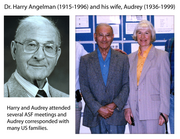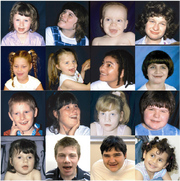Angelman Syndrome (AS) is a neuro-genetic disorder that occurs in about 1 in 20,000 births. AS is generally characterized by developmental delay, lack of speech, seizures, and walking and balance problems. These symptoms are usually not noticeable until about 6-12 months into the development of the child.
AS was first identified by the physician Harry Angelman in 1965 when he described several children in his practice as having “flat heads, jerky movements, protruding tongues, and bouts of laughter.” Due to the scarcity of cases at the time many people doubted its existence figuring that it was just other disorders such as autism or cerebral palsy. It was not until 1987 when Ellen Magenis identified the actual chromosome that caused the disorder and discovered that it was different from the other disorders.

Dr. Harry Angelman and his wife Audrey
Detection/Diagnosis[]
Angelman Syndrome is primarily detected when a child is about two to five years old once developmental issues become more evident. Before two years of age, problems with growth and development may not be specific enough to cause suspicion. Parents may only start to suspect that their child has Angelman

Chromosome 15 Where the Mutation that Causes AS Occurs
Syndrome if they meet with another child who has the genetic disorder or if they have read up on it previously. There are some criteria by which the diagnosis of Angelman Syndrome is based on:
- An impediment in development, severe enough to interfere with functionality.
- Hypermotoric behavior, including waving, clapping, and flapping of the hands, overly excitable personality, smiling/laughing a lot.
- Occurrence of seizures in kids less than 3 years old. Seizures decrease with age but can still occur at any point in their life.
- Stiff-legged bearing
- A deletion on chromosome 15 that causes a mutation
If there is history of epilepsy and/or a history of a slowed motor response, doctors have a pretty good indication that the child has Angelman Syndrome. How much this disorder affects a person is dependent on the severity of the condition and when it is actually diagnosed.
Due to its similarities to other disorders, Angelman Syndrome is often misdiagnosed as Autism, Cerebral Palsy, and Prader-Willi Syndrome. There are even some very rare cases where children have been diagnosed with AS and co-morbid autism which means that they have both. Often, however, it will be initially diagnosed as another disorder until more symptoms begin to appear.
In order to confirm a diagnosis of Angelman Syndrome, a genetic analysis is done by taking a blood sample. A compliation of the results from several gentic studies can show the dmagae done to chromosome 15 that causes the genetic disorder. Some of the tests include:
- DNA methylation test. This is a test to determine the pattern of imprinting. A person with Angelman syndrome shows only a paternal pattern in the affected gene as opposed to showing both the maternal and paternal pattern.
- Fluorescent in situ hybridization (FISH). This test is done to see if any chromosomes are missing in your gene sequence.
- Chromosome analysis ( karyotyping). In this test, the size, shape and number of chromosomes in a cell sample are examined.
Gene Expression/Regulation[]
Angelman Syndrome is most commonly a result of a deletion in your gene sequence. In most genes, both genes in a pair are turned on, one that comes from your mother and one from your father. But there are special genes that only activate one gene in the pair. This is dependent on whether the gene came from your mother or father, this type of regulation in called imprinting. Usually, the only UBE3A gene that is activated comes form your mother. However, kids with Angelman Syndrome, usually have missing or damaged genes in chromosome 15. This causes the symptoms and complications that come from Angelman Syndrome.
Treatment[]
Treatment is currently limited to mostly ongoing speech, physical, and occupational therapy. There is no cure currently available so different drugs are used only to treat individual symptoms. Individuals with the disease will need special attention in school and constant care throughout most if not all of their lives.
thumb|left|300px
Symptoms[]
People who have Angelman Syndrome may have symptoms of different severity, including:

Children with Angelman Syndrome
- Microbrachycephaly- smaller head size than usual. Sometimes the back of the head is flat
- Strabismus (cross-eyes)
- Darting tongue
- Jaw that sticks out
- Inability to walk or balance properly
- Jerky movement of arms and legs
- Frequent smiling
- Overly excitable personalities
- Lack of or minimal speech
- Hypopigmentation- light hair color, skin color, eye color
Life Expectancy/Quality of Life[]
Young adults with AS will continue to learn with little or no mental deterioration. The physical health of individuals with AS is usually very good except for the possible severity and frequency of seizures which often requires that individuals with the disorder remain on anticonvulsant for the rest of their lives. Some individuals may lose their ability to walk overtime if they are not encouraged to move around a lot or they may develop scoliosis.
Puberty begins around the same time it usually does in most healthy adolescents and the development of secondary sex organs is unaffected by AS. There is a case of a woman with AS successfully carrying and giving birth to a female child who was healthy in every way except for inheriting the disorder from her mother.
In adults, many of the problems are only continuations of those present in childhood but in a less severe form. These include seizures, jerky movements and behavioral issues. Most adults with practice are able to eventually dress themselves and eat with a knife and fork, though their abilities tend to stop beyond simple household chores. It does not appear that any major neuro-degeneration occurs or that life span is greatly affected by AS. While there are some who believe that AS may shorten a person’s life span by about 10-12 years, there is not enough data to accurately determine if it is truly shorter in individuals with AS.
Health Complications[]
As a result of Angelman Disorder, there are some complications that may occur. Some of them can be suppressed by medication, while others need to be carefully monitored so as not to cause injury or additional problems.
- Seizures: More than 90% of individuals with AS have been reported to have seizures, however fewer than 25% have seizures before they reach 12 months old. The seizures can be of any type and therefore can sometimes but tough to tell apart from the child's already jerky movements. Often a seizure medication is prescribed to children but is often stopped as a young adult because the seizures rarely persist into adulthood.
- Sleeping Disorders: Angelman Synrome may cause the sleeping patterns of people to change and become sporadic. Some people lose the affinity for sleep and can function without as much sleep as they once needed. When people with Angelman Syndrome start to suffer from irregular sleep patterns, medication may be prescribed to help control and regulate sleep.
- Hyperactivity: Especially when children are young, those with Angelman Syndrome can have amplified motor activity that may affect each child differently. Some children may lack the ability to concentrate for long periods of time; some may switch the activity they were doing frequently and quickly. Because hyperactivity may decrease with age and maturation, medication is not usually necessary.
- Temperature Sensitivity: Many children with Angelman Syndrome have been reported to have an extremely high sensitivity to changes in temperatures indoors and out. They do however appear to have normally body temperature controls such as sweating so this sensitivity does not appear to cause any severe problems other than irritability and increased hyperactivity when in warm rooms.
Sources[]
[1] Angelman.org
[2] US National Library of Medicine
[3] National Institute of Neurological Disorders and Stroke
[4] MayoClinic.com
By Brian Dooley and Kiran Sandilya